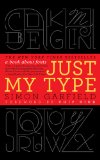Summary | Excerpt | Reviews | Beyond the Book | Readalikes | Genres & Themes | Author Bio

Critics' Opinion:
Readers' Opinion:
First Published:
Sep 2011, 356 pages
Paperback:
Sep 2012, 384 pages
 Book Reviewed by:
Book Reviewed by:
Poornima Apte
Buy This Book
Introduction
On 12 June 2005, a fifty-year-old man stood up in
front of a crowd of students at Stanford University
and spoke of his campus days at a 'lesser institution' - Reed
College in Portland, Oregon. 'Throughout the campus,' he
remembered, 'every poster, every label on every drawer,
was beautifully hand calligraphed. Because I had dropped
out and didn't have to take the normal classes, I decided to
take a calligraphy class to learn how to do this. I learned
about serif and sans serif typefaces, about varying the
amount of space between different letter combinations,
about what makes great typography great. It was beautiful,
historical, artistically subtle in a way that science can't
capture, and I found it fascinating.'
At the time, the student, who would later drop out of
college, believed that nothing he had learned would find
a practical application in his life. But things changed. Ten
years after his college experience, that man, by the name
of Steve Jobs, designed his first Macintosh computer, a
machine that came with something unprecedented - a wide
choice of fonts. As well as including familiar types such as
Times New Roman and Helvetica, Jobs introduced several
new designs, and had evidently taken some care in their
appearance and naming. They were named after cities he
loved, such as Chicago and Toronto. He wanted each of
them to be as distinct and beautiful as the calligraphy he
had encountered a decade earlier, and at least two of the
fonts - Venice and Los Angeles - had a handwritten look
to them.
It was the beginning of something - a seismic shift in
our everyday relationship with letters and with type. An
innovation that, within another decade or so, would place
the word 'font' - previously a piece of technical language
limited to the design and printing trade - in the vocabulary
of every computer user.
You can't easily find Jobs's original typefaces these days,
which may be just as well: they are coarsely pixelated and
cumbersome to manipulate. But the ability to change fonts
at all seemed like technology from another planet. Before
the Macintosh of 1984, primitive computers offered up
one dull typeface, and good luck trying to italicize it. But
now there was a choice of alphabets that did their best to
re-create something we were used to from the real world.
Chief among them was Chicago, which Apple used for all
its menus and dialogs on screen, right through to the early
iPods. But you could also opt for old black letters that
resembled the work of Chaucerian scribes London, clean
Swiss letters that reflected corporate modernism Geneva,
or tall and airy letters that could have graced the menus of
ocean liners New York. There was even San Francisco, a font
that looked as if it had been torn from newspapers - useful
for tedious school projects and ransom notes.
IBM and Microsoft would soon do their best to follow
Apple's lead, while domestic printers (a novel concept
at the time) began to be marketed not only on their
speed but for the variety of their fonts. These days the
concept of 'desktop publishing' conjures up a world of
dodgy party invitations and soggy community magazines,
but it marked a glorious freedom from the tyranny of
professional typesetters and the frustrations of rubbing
a sheet of Letraset. A personal change of typeface really
said something: a creative move towards expressiveness, a
liberating playfulness with words.
And today we can imagine no simpler everyday artistic
freedom than that pull-down font menu. Here is the spill
of history, the echo of Johannes Gutenberg with every
key tap. Here are names we recognize: Helvetica, Times
New Roman, Palatino and Gill Sans. Here are the names
from folios and flaking manuscripts: Bembo, Baskerville
and Caslon. Here are possibilities for flair: Bodoni, Didot
and Book Antiqua. And here are the risks of ridicule:
Brush Script, Herculanum and Braggadocio. Twenty
years ago we hardly knew them, but now we all have
favourites. Computers have rendered us all gods of type,
a privilege we could never have anticipated in the age of
the typewriter.
Excerpted from Just My Type by Simon Garfield. Copyright (c) 2011 by Simon Garfield. Reprinted by arrangement with Gotham Books, a member of Penguin Group (USA), Inc.




A classic is a book that has never finished saying what it has to say
Click Here to find out who said this, as well as discovering other famous literary quotes!
Your guide toexceptional books
BookBrowse seeks out and recommends the best in contemporary fiction and nonfiction—books that not only engage and entertain but also deepen our understanding of ourselves and the world around us.